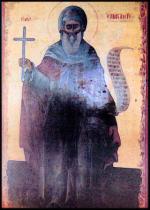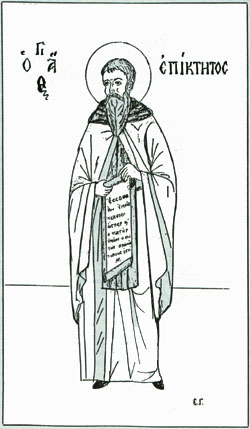[ Saint Epiktitos ] [ Postal Service ]
Biography of Saint Epiktitos the Miraculous
Biography of Ayios Epiktitos (Saint Epiktitos)
|
|
Ayios Epiktitos village took its name from Saint Epiktitos (Ayios
Epiktitos). According to the historian Leontios Macheras
he was one of the 300 Christians that came from Palestine to Cyprus at
1187 A.C after participating in the Second crusade 1147-1149 A.C. He lived
and died in the location where our village lies. The village was
established after 1200 A.C. (according to "Horia ke polis"
(Villages and towns) of historian Kliridis).
|
Leontios Macheras, the chronographer of Cyprus, in his "Chronicle" describes the particular event.
<<'Οταν οί Σαρακηνοί επήραν τήν γήν τής Επαγγελίας, τότε εβγήκαν οί πτωχοί Χριστιανοί απού εγλυτώσαν καί επήγαν όπου ηύραν καταφύγιν ήσαν αρχιεπισκόποι, επισκόποι, ιερείς, λαϊκοί καί επήγαν όπου φτάσαν καί ήρταν καί είς τήν περίφημον Κύπρον μία συντροφιά, όπου ήσαν τ' (300) ονομάτοι, καί γροικώντα ότι Έλληνες εφεντεύγαν τόν τόπον, διά τόν φόβον επήγαν είς τό ένα μέρος καί είς τό άλλον καί έσκαψαν τήν γήν καί εμπήκαν μέσα καί επροσεύχονταν τώ Θεώ καί ήσαν δύο τρείς αντάμα, καί είχαν τινάν δουλευτήν απού τούς εδούλευγεν τό εχρειάζουνταν διά τήν ζωήν τούς καί εποθάναν είς τόν αυτόν νησίν, καί πολλοί εξ' αυτών τούς εφανερώθησαν δι' αγγέλου άλλοι διά τά θαυμαστά θαύματα. >>
Historian Macheras gives 67 names out of the 300 among them the name
of Ayios Epiktitos.
Saint Epiktitos is said to have traveled to the North mountainous terrain of
Cyprus, "Pentadactylos" and settled at the location of "Kaza
Pifani" (Καζά Πιφανή)
the nowadays known village of Kazaphani which is approximately 4 miles away from
the town of Kyrenia.
<<Είς τήν
Περιστερώναν
τής Μεσαορίας
ευρίσκεται ο
Άγιος
Αναστάσιος ό
θαυματουργός
είς την
Ορμετίαν (Ορμήδια)
ό Άγιος
Κωνσταντίνος
στρατιώτης ...
καί προς τού
Κάζα Πιφάνη ό
Άγιος
Επίκτητος. >>
 |
Το Απολυτίκιον του Αγίου Επικτήτου |
| <<Της ερήμου πολίτης και εν σώματι άγγελος και θαυματουργός ανεδείχθης Θεοφόρε, πατήρ ημών Επίκτητε. Νηστεία αγρυπνία, προσευχή, ουράνια χαρίσματα λαβών, θεραπεύεις τους νοσούντας και τας ψυχάς των πίστη προστρεχόντων Σοι. Δόξα τω δεδώκοτι Σοι ισχύ. Δόξα τω σε στεφανώσαντι. Δόξα τω ενεργούντι δια σου πάσιν ιάματα.>> |
